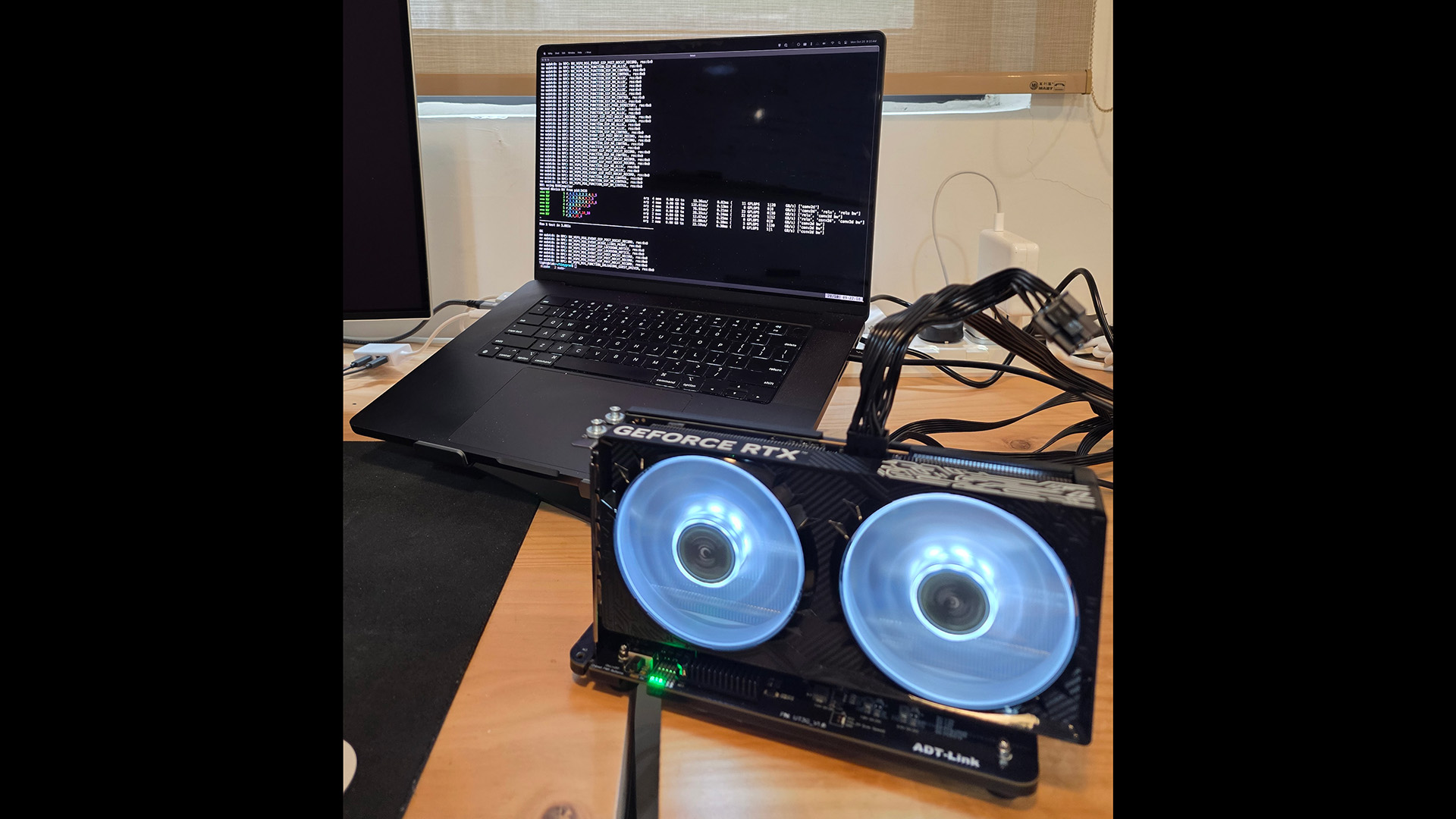Apple MacBook successfully runs an Nvidia GPU through USB4 using an external docking station - Tiny Corp's coding wizardry unlocks Mac+Nvidia magic
AI developers can now run LLMs or other AI workloads on ARM-based MacBooks with the power of Nvidia RTX GPUs.

After getting AMD graphics cards to work on ARM-based MacBooks, TinyCorp has successfully ported its work to USB4/Thunderbolt 4 and built drivers to make Nvidia's RTX 30, 40, and 50 series graphics cards work with MacBooks through external GPU docking stations using either connectivity standard. However, before you get your hopes up, these drivers are designed specifically for AI development and won't get you display functionality on MacBook devices.
The AI startup showed off this new capability on X with instructions on how to install the drivers for AI developers. TinyCorp also shared an image of a MacBook Pro M3 Max running Tinygrad off of an (unnamed) RTX GPU hooked up to an ADT-UT3G dock using USB4.
For now, RTX 30, 40, and 50 series graphics cards are supported. The AI startup mentions that the RTX 20 series might work, but requires additional work on the user's end. The main issue is that TinyCorp's drivers only work with Nvidia GPUs featuring a GPU system processor, which is why no GTX-series graphics cards are supported. AMD GPUs based on RDNA 2, 3, and 4 reportedly work as well.
NVIDIA over USB4 on MacBook is ready to try!* ADT-UT3G dock + any 30/40/50 series GPU* Disable SIP* Install driver `extra/usbgpu/tbgpu`* Install NVK compiler `brew install tinymesa`* Test with:`DEBUG=2 NV_NAK=1 NV=1 python3 test/test_tiny.py TestTiny.test_plus` pic.twitter.com/bWVVmC4x8EOctober 20, 2025
Getting Nvidia GPUs to run on Apple products has been pretty much impossible ever since Apple ditched Intel processors and switched to its homebrewed M-series processors running on the ARM architecture. Apple's M-series MacBooks are powered exclusively by one massive iGPU inside, so there has not been any requirement for Apple to implement Nvidia or AMD driver support in the ARM versions of MacOS.
This has forced developers and users to make their own drivers by hand for any chance to make MacOS work with Nvidia or AMD graphics cards running on external GPU docks. Luckily for TinyCorp, the AI startup already had experience building all the necessary drivers to run eGPUs on ARM-based MacBooks after it created the world's first external AMD graphics card driven on Apple silicon with USB3, a standard that doesn't even include PCI Express.
TinyCorp's X did not share many details about the development pitfalls the AI-startup inevitably had to plow through to get Nvidia GPUs working on ARM-based MacBooks through USB4 and Thunderbolt 4. But, it was likely easier for TinyCorp to implement Nvidia support with external GPU docks for M-series MacBooks, with their prior experience building the same setup for AMD GPUs on USB3.
USB4/Thunderbolt 4 is also tailor-made for devices such as external GPU docks, boasting native PCIe support, which probably simplifies support further. Not to mention the massive bandwidth improvements USB4/Thunderbolt 4 boasts over classic USB3.
Get Tom's Hardware's best news and in-depth reviews, straight to your inbox.
For the AI crowd, this new capability of running Nvidia GPUs on ARM MacBooks will be highly beneficial for running local LLMs and other AI models on cards such as the RTX 5090 at a much faster rate than what Apple's M-series GPUs can achieve.

Follow Tom's Hardware on Google News, or add us as a preferred source, to get our latest news, analysis, & reviews in your feeds.

Aaron Klotz is a contributing writer for Tom’s Hardware, covering news related to computer hardware such as CPUs, and graphics cards.
-
ezst036 Why waste so much effort on such a locked down platform that has such hostility toward modders? So few people are going to do this what is the benefit?Reply -
JamesJones44 Reply
Because for development macOS and Linux are fair easier platforms to deal with and aligns with Linux workloads that run in typical cloud environments. Windows is the hostile environment for developers. The tools are bad, the kernel is terrible, file locks are non-sensical, the scripts you build and the environment does not aligns with typical cloud environments (include Azure). WSL is a hack that works sometimes, but often is not worth the pain one has to go through to get everything working only to have MS release an update that breaks everything.ezst036 said:Why waste so much effort on such a locked down platform that has such hostility toward modders? So few people are going to do this what is the benefit? -
kealii123 Reply
any time I try to get any programming work done at all on a Windows machine I get the feeling that Microsoft actively doesnt want me using their products. It feels almost intentional.JamesJones44 said:Because for development macOS and Linux are fair easier platforms to deal with and aligns with Linux workloads that run in typical cloud environments. Windows is the hostile environment for developers. The tools are bad, the kernel is terrible, file locks are non-sensical, the scripts you build and the environment does not aligns with typical cloud environments (include Azure). WSL is a hack that works sometimes, but often is not worth the pain one has to go through to get everything working only to have MS release an update that breaks everything. -
kealii123 This is cool and all, but kinda pointless. For large LLMs, apple silicon already punches above its weight, getting tok/sec within spitting distance of the very best desktop GPUs.Reply
The real constraint on LLMs isnt raw GPU power anyways, its VRAM, and Apple wins that battle almost every time, even on a cost/performane analysis. -
SysDeb011 Reply
Look on the bright side — we will now be able to make Hackintosh setups with Nvidia GPUs :Dezst036 said:Why waste so much effort on such a locked down platform that has such hostility toward modders? So few people are going to do this what is the benefit? -
ezst036 Reply
That is awesome. I thought Hackintosh was dead with the ARMac though? Are people having success installing the newest versions of MacOS on the limited ARM options out there?SysDeb011 said:Look on the bright side — we will now be able to make Hackintosh setups with Nvidia GPUs :D -
kealii123 Reply
I would if I could. My macbook pro display is better than 90% of PC laptops, and I need a macbook for work anyways. Nearly impossible to do software engineering on a modern Windows device, plus the hardware outside of Apple Silicon is 2-3 generations behind. That way I can have just one device.charles_75 said:Want to play 5 star games on MacBook?
MacOS gaming compatibility will never be good eough. Apple makes too much money off gaming on the iOS store to everr care (serioiusly, more than xbox, all PC gaming, PS5, and Nintendo combined)